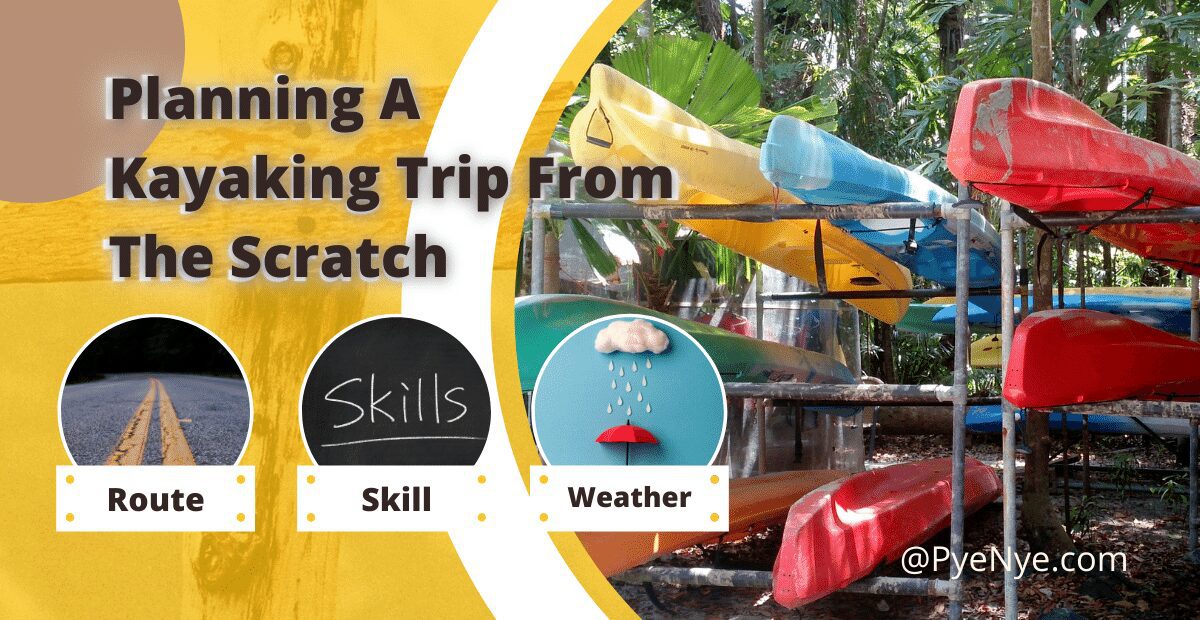Planning a kayaking trip can be a challenging feat, especially when the only thing you know is that you want to go out on the water. If you are considering going on a long kayak trip, you may need to prepare for the conditions out there. In order to prepare for a long kayak trip, you will need to make sure your kayak is sturdy enough for the rough seas and strong winds that can happen during storms. So never compromise with kayaking safeties.
In preparation for a long kayaking trip, you want to map out your route and find out what to bring. If the water is cold, it’s recommended to wear a dry suit. Bring plenty of food, bottled water, and a sleeping bag or blankets so you can stay warm while camping on some of the more remote islands. Camping supplies should include a portable stove, some cooking utensils, a makeshift windscreen, and a tent with a rainfly.
And your craft should have adequate storage space for all of your gear.

Jump To A Section
How To Prepare For A Long Kayak Trip?
Preparing for a long kayak trip is often more complicated than preparing for shorter trips. The longer the kayaking expedition, the more supplies you will need to bring with you, and the more food you will need to ration. You will also need to make sure that your kayak is fitted for your body type before your departure date.
Kayaking is a great way to learn about nature and the environment, play outside with friends, and get in shape. If you are considering going on a long kayak trip, you may need to prepare for any conditions out there. In order to prepare for a long kayak trip, you will need to make sure your kayak is sturdy enough for the rough seas and strong winds that can happen during storms.
A long kayak trip can lead to dehydration, heat stroke, and sunburn. It is very important to be prepared for any of these issues with plenty of water, sunscreen, and a hat.
In order to prepare for a long kayak trip, one should do a thorough inventory of their food, water, and equipment. One should also have a detailed map of the area they will be going to, so they can plan out their itinerary. Finally, one should have a GPS device in order to keep tabs on where they are going.
Learn To Deal With Sudden Weather Changes During Kayaking
A kayaker is more likely to experience these sudden changes in weather because they are often traveling downstream or may face an oncoming storm.
During sudden changes in weather, kayakers should be aware of the current conditions and the forecast. They should also know what type of boat they are using and what type of paddling they are doing. If there’s any chance that bad weather will arrive faster than expected, kayakers should prepare their boats for an emergency by strapping them down to prevent them from floating away with any sudden waves or rapid currents. If things seem too risky, it might be best to cancel the trip.
Track The Distance When You’re On long Kayaking Trips
It is important to know how far you are paddling to make sure you don’t get lost or go too far.
Miles are measured on the ocean based on the number of fathoms horizontal distance–this distance is multiplied by 6 to convert it into miles.
To track distance, kayakers use a GPS and their known course to calculate how far they’ve gone. For example: Let’s say the kayak starts at Point A and Point B is 100 miles away. Point C is halfway between Point A and Point B, but Point C is only 50 miles away from Point A.
Know your limits When Planning A Kayaking Trip
The most important thing to consider when deciding how far you’d like to go is your abilities and stamina.
Many of us stop kayaking after just one or two days on the water, and others decide to keep going until they can’t make it any longer.
Checklist For Planning Kayaking Trips
- Check the weather forecast
- Pack appropriate clothing and equipment
- Prepare food that can be carried in a small cooler or drybag
- Carry a waterproof map of the area
- Let someone know where you are going and when they should expect to hear from you again
- Bring navigation devices in case something goes wrong.
Planning An Overnight Kayaking Trip
There are several things to consider before planning an overnight kayaking trip. For instance, you need to decide where you will camp, and you should keep in mind that the weather conditions may be very unpredictable. Have a look at the night kayaking guidelines for more details.
Make sure to research the local climate before you leave for your trip. Likewise, you should prepare emergency supplies and pack your backpack accordingly. If you have a large group, be sure to let them know that you will be camping in an unfamiliar location.
When planning an overnight kayak trip, it is very important to consider all relevant equipment needed, such as clothing, tents, cooking gear, and kayaking safety equipment. These items include but are not limited to wet weather clothes and jackets, head torches, fire starters, batteries, tools, a compass, maps, lifejackets, first aid kits, and so on. It is vital that you check with the local authorities before setting off whether or not you need any special permits or licenses.
It’s important to know when you’ll leave, where you’ll stay, and when you will return home again. If you have to stop for the night, think about the best spot for your campsite.
Finally, enjoy yourself. It might seem daunting to pack enough food and water to survive for a whole day, but be careful about the safeties!
Everything You Need To Know About Planning A Kayaking Trip
Kayaking trips are great fun. But planning a perfect kayaking trip takes time and effort. There’s no point going kayaking if you don’t have an idea of where you want to go or what you’re looking for in a trip—and those two things change depending on who’s paddling with you. Planning a kayaking trip can be hard to know what sort of kayaking experience you need when you haven’t planned properly in advance. Here are the things that make kayaking hard and difficult.
However, we’ve pulled together some advice that will help you choose the right kayaking trip for you…
- Consider Weather Conditions
If there are likely to be strong winds or rough seas, you could end up spending more time waiting for conditions to change rather than actually enjoying yourself. But don’t let weather worries hold you back. With careful preparation, you can have a great day regardless of the weather.
- Skilling Level
Think about the level of physical fitness you have before embarking on a trip. Some people start by kayaking around rivers and local lakes to build up their strength gradually. Others prefer something more challenging straightaway.
And many of us would love to try a multi-day expedition, which requires completely different skills. Remember, too, that water temperatures vary from place to place, so if you haven’t done enough exercise training, don’t expect your body to cope! Here’s everything about kayaking exercises.
- Know What You Want
Before you hit the road, you need to decide what kind of journey you want. Is it a long weekend, a weeklong vacation, or somewhere between? Think about where you’d like to go first. Then plan your kayaking trip accordingly to narrow down your choices.
- Make a List
Take a piece of paper, write down the details of each destination. And plan a route from one end to the other. Work out the total length of your trip, including stops. Then take another piece of paper and draw a line down the center as though you were plotting your course map: list all the destinations in order, starting at one end and adding the next until you reach the opposite side. This gives you a clear idea of how far apart you’ll encounter the various pieces of the countryside. Don’t worry if you get stuck; just add the distance between destinations to your original total.
- Time Frame
It all starts at home. Before you even think about booking anything, it pays to work out whether this is something
you can fit into your life right now; if you aren’t able to, there’s not much point thinking about it any further. If you’re too busy to get away, consider making a half-day trip instead; it’s still better than nothing.
- Food, Clothing & Shelter
You’ll also need to make sure you have everything you need during your trip. You should pack plenty of food and drink because you won’t always find shops along the way, and you may have to buy supplies along the way. Waterproof bags and a waterproof cover for your bag are useful. For overnight kayaking trips, bring a sleeping bag, torch (flashlight), groundsheet, tent, stove, cook kit, and extra fuel.
- Friends and Family
Don’t forget to tell friends and family about your plans! They might offer to come along too. Or they can keep you company on social media sites like Facebook or Twitter, where fellow
kayakers share photos and recommendations. Your social network can be a valuable source of information – both good and bad. Some people are only happy if they’ve booked the best deal possible, while others are keen to hear about other places and adventures.
In conclusion, plan ahead for your kayaking trip by considering these rules. There are many places to kayak, including rivers, lakes, and oceans. It is important to conduct internet research before embarking on your trip, so you know what the weather will be like and what gear you will need.


